


|
Get it on video
Cameras are everywhere these days, as are cell phones with ever-improving photo and video capabilities. The "best camera" is always the one you have on hand, so make it a good one. Phone cameras are excellent (and handy), but DashCams, HelmetCams, SecurityCams and even SpyCams capture quality video in ways a handheld camera might not. With a little ingenuity, these dedicated cams can be automated to various degrees, too.
Mount and application ActionCams, like the other categories mentioned above, are designed with a specific use in mind, the primary difference being image stabilization. A securely mounted cam is inherently stable, but body cams, handheld and helmet cams typically produce shaky video by the nature of their use. Image stabilization uses a large image sensor to produce a smaller, stabilized image. For example, a 4K sensor might record stabilized 1080p video by staying on target with remainder of image size sacrificed as a buffer against motion. Unfortunately, the term 'ActionCam' does not necessarily include image stabilization.
If you're looking for top-quality output, price will certainly be a major factor; many such cameras are in the $500 range with fast shutter speeds, quality audio, high-resolution video and stabilization built-in. But, we're ignoring these big, bulky and expensive cameras in favor of broadcast quality video from far less expensive units.
Battery-powered 3-axis gimbal stabilizers for use with cams and phones are available, if these suit your purpose. One of the first was the DJI Osmo. A software solution known as Gyroflow ($10, open-source) can be used with cams that make use of gyro data, it allows fine-tuning in countless ways, adding stabilization within select video editing apps.
The above are all great solutions for professional video; for the sake of size and weight, all but basic recording is eliminated from "pillbox" cams often used on drones. Action cams typically have more features at a higher price. Best solution might be in-camera Electronic Image Stabilization (EIS). Otherwise, getting creative with camera mount can go a long ways toward better video.
As used here, minimum broadcast quality means 1080p (1920 by 1080) at 30 frames per second (fps). Technically, lowest acceptable is 720p. Naturally, 4K is better, as is 60fps, but file size and storage is another consideration and 1080p/30fps in H.264 format is something of a sweet spot for us rank amateurs.
Be aware that some cheapo cams advertise frame rates and specs that are absolutely false, and the market is saturated with these no-name devices. Cameras discussed below have proven to produce outstanding video in a tiny package making all sorts of applications possible. Sources listed on this page are known and verified, presented only for convenience; nCity is not affiliated with any manufacturer or vendor. There may be some new gems out there we're unaware of, too. Links are at bottom of this page.
Getting started It helps to be familiar with editing software and to settle on specs and requirements that suit your purpose. For example, file size (determined by image size, resolution, frame rate and file format) will dictate storage requirements. If you've shot any video at all, you know how large video files can be. Cards used are typically micro-SD class 10 or better.
PROCEED AT YOUR OWN RISK!
Jump down page to:
Camera considerations, types, lenses + more
CCD and CMOS sensors
Infrared Cut filters (aka IR-cut or "hot mirror" filters) Operation by Remote and Automation File types, playback and editing |



ActionCams, SecurityCams and lens options The majority of both action and security cameras share a common lens type known as M12. ActionCams typically use wide-angle lenses while SecurityCams tend to have a more focused or close-up Field Of View (FOV). Image distortion can be considerable over 100º (most ActionCams), and a FOV below
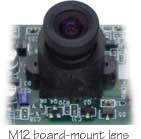 30º might be too tight, depending on objective. Somewhere between 40º and 60º may be considered "normal," 70º to 85º is an acceptable wide-angle compromise, and there are other ways to minimize fisheye via programming in some cameras. 30º might be too tight, depending on objective. Somewhere between 40º and 60º may be considered "normal," 70º to 85º is an acceptable wide-angle compromise, and there are other ways to minimize fisheye via programming in some cameras. Why care about FOV and various lenses? If your goal is to cram maximum information or FOV into the frame, a wide-angle lens is the only way to go, which is why fisheye has become ubiquitous as the hallmark of ActionCam video. If you're happy with your camera's lens (saving yourself much of what follows), stick with it. Read on for mounts, power and other mods you might find useful. If you prefer a "normal" FOV with minimum distortion and better focus on your target, you may find options available in your camera of choice. |
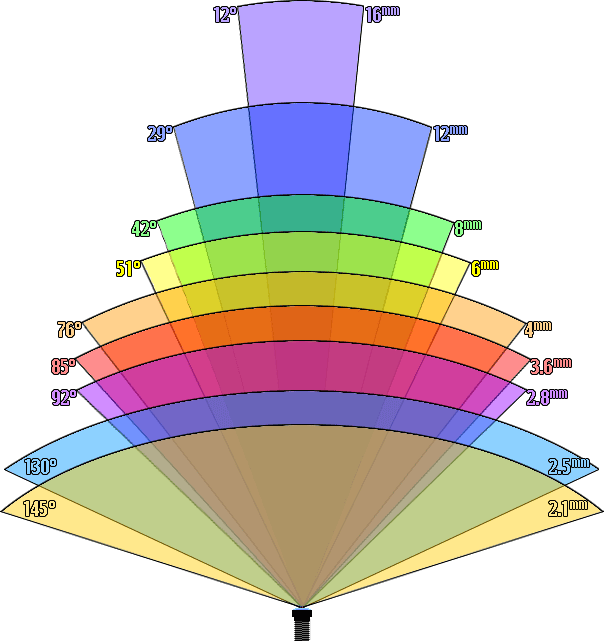 Field of view (FOV) and focal length for M12 lenses ©2013 nCity |
It's important to note that sensor size will affect FOV and image quality, as does the chip set used, lens response time and firmware running the camera. Sensors, chip sets, lenses and cameras have all improved a great deal in recent years and will continue to improve as time goes on.
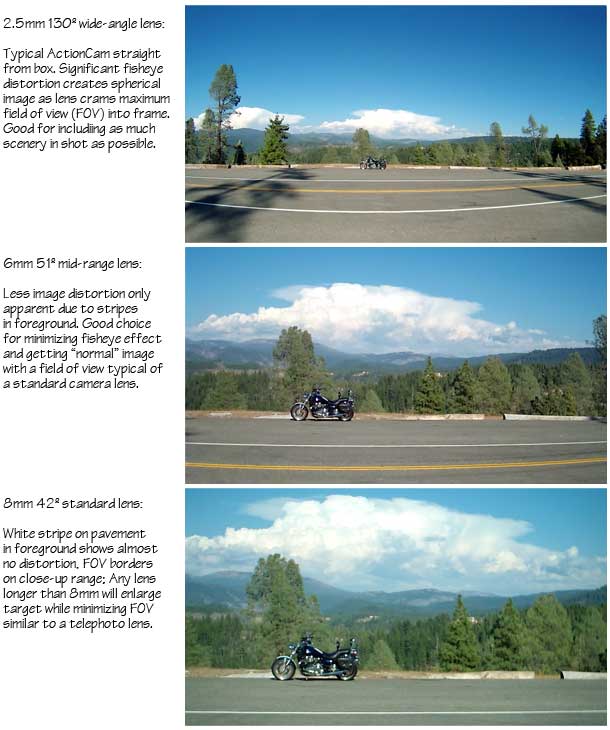 The three (reduced) stills above are from three old Drift cams shown below, all mounted together to demonstrate FOV difference between lenses. Distance from cameras to motorcycle was about 20 yards (60 feet).
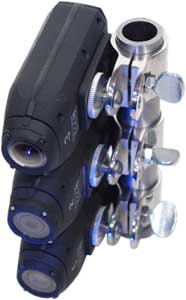 1st still is from the Drift's OEM 2.5mm lens. Unwanted inclusion of objects surrounding the camera becomes a problem when mounting a cam. Unless placed at extreme front or rear of vehicle, a large portion of frame will be consumed by nearby fenders, handlebars, helmet, or other things that may detract from shot. 2nd still accurately shows target and frames clouds nicely while cropping out distractions and presenting more-or-less what the eye sees with a 51º field of view. 6mm lens is good choice for general-purpose video. 3rd still from 8mm lens begins to enlarge target and is well suited for distortion-free shots with a specific target. Objects within about 20 feet or so will fill frame, making it perfect for filming other riders or vehicles. You may notice a slightly different color balance in this shot, too, which is a function of its IR-cut filter: The weaker the filter, the less color saturation it produces as infrared begins to overwhelm other frequencies. Use a high-quality IR-cut filter. New Drift cams feature EIS and a host of features and mounts that make it a great choice as an action cam in the $250-300 range.
|

|
The BFD about CCD and CMOS How complicated can it be, right? Plenty. Read all about it if you like, but here's the short version:
CCD was analog, sharp and smooth, from security cam and CCTV systems. CMOS is digital, fast and easy, used in mobile devices and computers. (CCD = charge coupled device, CMOS = complimentary metal oxide silicon, aka "sea-moss.")
Okay, let's be honest. Analog video doesn't stutter, it doesn't stall or drop frames or make chunky exposure/color adjustments on the fly. But we're dealing with _digital_ video here that can do all those things, and the objective is to avoid all of 'em in pursuit of the one concern that is critical to both types: Image quality (resolution, color balance, exposure and smooth playback). Cameras may use either CCD or CMOS sensors with identical lenses and IR-cut filters to produce digital video output, so while it's helpful to know which sensor/lens/filter combo your camera of choice uses, sensor type really doesn't matter much if output is acceptable. Both types are equally sensitive to infrared wavelengths, BTW. 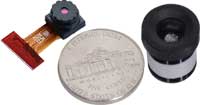 Micro pinhole lens assembly (left), and a typical M12 lens |

|
Infrared (IR-cut) filters Most cameras have IR filters built-in for daytime use, but bare lenses will probably not include any filters. As it turns out, getting a good IR-cut filter can be the most difficult part of changing a lens, and mounting a filter can be tricky. IR-cut filters typically consist of a delicate coating on a small piece of glass positioned between sensor and lens, and the quality of this filter has everything to do with color balance. Digital video shot without an IR-cut filter (or with a poor one) will appear slightly fuzzy with little or no color. Not good.
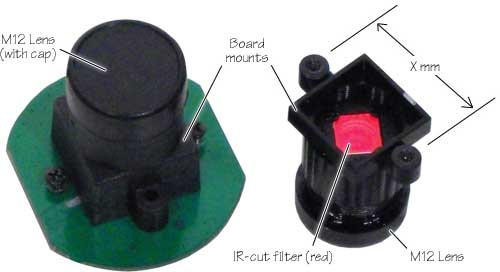 Two types of M12 lens mounts are shown above, one upside-down showing its IR filter attached to end of lens. Critical dimensions for board mounts are the distance between centers of mounting screws (X mm = 18mm, 20mm, 22mm, etc.), and the depth of "box" covering sensor and filter. Left lens has a deep box; lens on right has a very shallow box. Some mounts use a locking ring or spring tension to fix lens to mount, some have a set screw, but many are simply glued together. Depth of box determines distance to sensor. Focus is achieved by screwing lens in/out of mount (more on that later), but any contact between lens and sensor will likely damage both, so beware and make sure there is room and means to install IR-cut filter if necessary. |

|
Operation by remote or automation Cameras with remote controls are becoming common for good reason. A wireless remote eliminates having to grope for controls and allows easy start/stop without risking change in focus or direction by handling camera. Multiple mounted cams may all be activated simultaneously by a single remote, too, provided they've all been paired and setup. This function is important enough to be considered critical in many situations (driving, riding, etc.), and can be thought of as in-camera editing saving a lot of time later. Cams with a standby mode often have impressive battery life, lasting 4-8 hours or more. The alternative to remote control is programmed automation.
Programmable cameras may be set to record nonstop, re-recording over previous video in a continuous loop. Cameras with loop functions in their programming are commonly sold as dash-cams or "black-box" cameras and operate much like a so-called black-box in an aircraft. A physical shock or save button will lock current clip to prevent it being overwritten as camera continues to record. Autosave options are entirely a function of camera's programming, and options vary between brands. Otherwise, a non-stop loop may be used to capture everything, but be prepared for reviewing hours of video. Many cameras will have firmware updates from time-to-time, depending on manufacturer. Some use a computer file that may be modified and customized before loading into camera, where it becomes camera's configuration file (or "script"). Notable among these is the Mobius. Being about the size of a Zippo lighter allows Mobius cams to serve in ways that bigger, bulkier, and heavier cameras cannot. |

|
File type and editing: Resolution, playback, size and apps H.264 codec is best choice for editing purposes, thanks to its video quality and compression. Also known as .MOV or MPEG-4, H.264 is supported by most computers, handheld devices, web browsers and editing software, H.264 should be considered a requirement for any camera you may choose. AVI will work, but having to convert video between formats is an extra step that's best avoided. Video codec also determines storage requirements, and H.264 can cut file size by 50% or more over other file formats.
As for resolution and frame rate, 720p at 30fps is considered minimum broadcast quality. 1080p is better, as is 60fps, and these settings can be mixed down for posting. 4K and above is overkill (IMHO), and not worth the extra burdens of storage and editing requirements. You may prefer to shoot at higher quality settings, but we're talking about 1GB/min. in some cases; depending on number of cams, edited versions and software, storage requirements can escalate quickly. (720p = 1280 x 720 pixels, 1080p = 1920 x 1080. Both are wide-format 16:9 aspect ratio.) At the very bottom of video quality is QVGA (320 x 240), followed by almost acceptable VGA (640 x 480), both in 4:3 aspect ratio. These might be considered "home movie" territory. If your goal is YouTube or web video, there's nothing wrong with shooting in VGA, tho aspect ratio may look a bit dated and image quality will suffer a bit. Once recorded it's impossible to improve video quality later, so - again - you may want to shoot higher quality and post reduced versions on the 'net. Editing video is a topic worthy of the many books and manuals written on the subject, and software options are legion, running from free (and easy) to hundreds of dollars. Final Cut Pro, Adobe Premier, Avid Composer are all high-end, top-notch apps, but there are some low-cost and free gems out there, too, starting with everybody's favorite iMovie. Windows users have Movie Maker for Windows 10 or later. Search "video editing software" for countless choices, but you're certainly going to need _something_ for video editing. As with everything these days, you get what you pay for (mostly), and free or light-weight video editing apps lack the pizazz of pro apps. Common considerations include aspect ratio, resolution, frame and format (file-type). Other things to consider include multi-cam support, audio editing, transitions, special effects and many other capabilities that may be desirable. Pro editing apps like Final Cut and Adobe Premier are sophisticated enough to handle just about anything, but these come with a learning curve that requires a serious commitment. Any editing beyond the most basic will also require dedicated hard drive space and backup drives. So there you have it. If shooting VGA video on the cheap is okay with you, the starter setup below will get you going (if you can still find these cams or similar models). |



|
Quick, cheap and easy starter setup - oldie but goodie If you're okay with a 640 x 480 VGA movie, here's a two-camera setup for far less than $100 using Vivitar's great little DVR 480 cameras (if still available) and an older version of iMovie HD (v6.0.3) that came free from Apple back in the day. Or, use Vivitar's video editing software that comes with this gem of a camera. (Later models eliminated the LCD screen on top which was very useful, but it's not a deal breaker.)
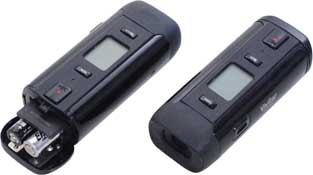 This lil' guy measures 11/2" x 33/4" x 1" thick and weighs less than 3oz. with batteries and card installed. It has a standard 1/4x20 camera mount on its bottom and LCD readout on top with a blue on/off LED. Best of all, it has a great lens and records at 30fps on a pair of AAA alkaline batteries. LCD displays battery status and recording time, about 4 hours in high resolution or 14 hours in low rez QVGA on a 16GB card. It comes with a variety of helmet and adhesive mounts, a USB cable, and a silicon cover to protect it in foul weather. At $20-35 apiece, you'll have plenty of money left over for batteries and SD cards. This lil' guy measures 11/2" x 33/4" x 1" thick and weighs less than 3oz. with batteries and card installed. It has a standard 1/4x20 camera mount on its bottom and LCD readout on top with a blue on/off LED. Best of all, it has a great lens and records at 30fps on a pair of AAA alkaline batteries. LCD displays battery status and recording time, about 4 hours in high resolution or 14 hours in low rez QVGA on a 16GB card. It comes with a variety of helmet and adhesive mounts, a USB cable, and a silicon cover to protect it in foul weather. At $20-35 apiece, you'll have plenty of money left over for batteries and SD cards.(TIP: The one and only minor glitch is that some of these cams have doors that catch on batteries when closing, but slipping a piece of paper past batteries while closing the door takes care o'that.) Vivitar DVR 480 teardown and audio mod: Like most video cameras, the DVR 480 also records audio. And, like most of these small video cameras, it's audio quality suffers from having its microphone inside its case. Once removed and made into an external mic, audio quality from this camera is outstanding. 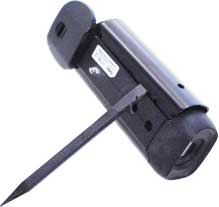 Remove batteries and memory card, then pry off side panels using a spudger (shown, aka "black stick," a soft plastic tool perfect for jobs like this), or use a plastic card to avoid damaging housing. (Just don't use a credit card, you'll need that later.) Start at rubber lens cover and work down each side toward camera rear to free clips. 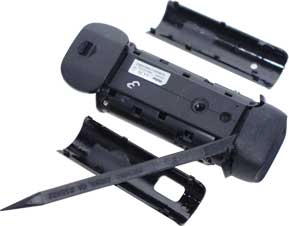 With both side panels removed, free the rubber "ears" of lens cover from slots on each side, then pop rubber lens cover from housing at top and bottom. With unit up-side-down, remove four phillips screws, two on each side. Remove two more short screws from front lens cover. Carefully pry housing halves apart and lift off unit's bottom case. With both side panels removed, free the rubber "ears" of lens cover from slots on each side, then pop rubber lens cover from housing at top and bottom. With unit up-side-down, remove four phillips screws, two on each side. Remove two more short screws from front lens cover. Carefully pry housing halves apart and lift off unit's bottom case.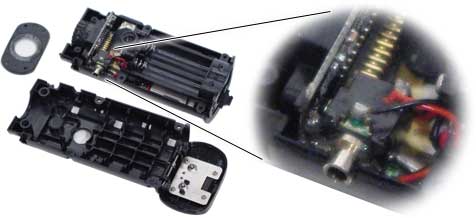 Microphone was removed and replaced with a 2.5mm jack from Radio Shack soldered to mic leads (red + to tip). Opening was cut in housing, a matching hole drilled thru side cover and jack was then epoxied in place. Observing polarity, mic was soldered to a short 3" cable with 2.5mm plug and placed in a fuzzy wind muff. Resulting audio from this motorcycle-mounted camera was much better than expected.
 To see five Vivitar 480s in action, including some audio after the mod above, see the 21st Annual NCFTR video post on YouTube (from 1 min mark). Cams were mounted front, rear, both sides + one down low on bike. All audio during the ride was from the 480 TailCam (if you can suffer thru it). |



|
Providing power to DashCams and ActionCams Primary modus operandi here is the ActionCam approach, and these are usually battery-powered in the 3-5vdc range and may be charged via USB. Record what you like, when you like, in short clips, with manual control and multiple mounting options (incl. HelmetCams). Or, if hard wiring to vehicle 12vdc is the plan, a USB adapter is the obvious choice for cams with USB ports (5v). Cigarette lighter adapters are common in the U.S. and Euro-style "powerlet" ports are provided on many import vehicles. Hard-wire or battery power, both have specific advantages and corresponding drawbacks.
Battery and USB power Needing a battery tender for winter, I found a nice one with this bullet connector and cap on it. Wired to battery lugs, this connector is concealed behind motorcycle's side cover where connecting battery tender is convenient. Happened to be right next to saddlebags, so I built a proper 12v adapter for use as USB/12v battery and device charger while on the road. Needing a battery tender for winter, I found a nice one with this bullet connector and cap on it. Wired to battery lugs, this connector is concealed behind motorcycle's side cover where connecting battery tender is convenient. Happened to be right next to saddlebags, so I built a proper 12v adapter for use as USB/12v battery and device charger while on the road.Pictured to right is a dual-port USB adapter, about the size of a cassette tape, 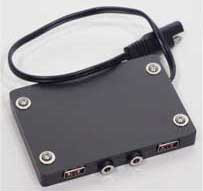 which also has two 12v-out jacks if needed. Each USB port is rated at 3000mA (3 amp) @ 5vdc, plenty of power for charging most any USB-powered gizmo. This adapter uses a pair of tiny N117 12v to 5v USB buck converters (pictured below in Mobius section), equipped with the same bullet connector/cable as that for battery tender (above). Adapter is mounted inside saddlebag where it is out of the way and easily accessible to charge cameras, batteries, GPS or iPhone while riding. which also has two 12v-out jacks if needed. Each USB port is rated at 3000mA (3 amp) @ 5vdc, plenty of power for charging most any USB-powered gizmo. This adapter uses a pair of tiny N117 12v to 5v USB buck converters (pictured below in Mobius section), equipped with the same bullet connector/cable as that for battery tender (above). Adapter is mounted inside saddlebag where it is out of the way and easily accessible to charge cameras, batteries, GPS or iPhone while riding.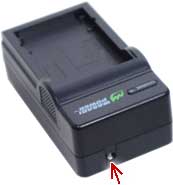 The Wasabi charger (pictured at left) came with a pair of batteries for my hand-held video camera; these chargers are available for just about any type of camera (from Amazon vendor Blue Nook, link at bottom). Both the Wasabi batteries and chargers are top-notch and well made. Chargers have retractable 120vac plugs and 12vdc in for mobile use (arrow). All this is great for recharging battery-powered handhelds and ActionCams. The Wasabi charger (pictured at left) came with a pair of batteries for my hand-held video camera; these chargers are available for just about any type of camera (from Amazon vendor Blue Nook, link at bottom). Both the Wasabi batteries and chargers are top-notch and well made. Chargers have retractable 120vac plugs and 12vdc in for mobile use (arrow). All this is great for recharging battery-powered handhelds and ActionCams.A hard-wired DashCam that continuously loops over previous recordings will catch everything that happens from vehicle ignition on to ignition off. Do the math and you should find a 32GB SD card gives you plenty of recording time (64GB for dual front/rear DashCams), especially if you use the shock/lock feature to retain clips while it continues to loop. Some have motion-detect, and time-lapse options as well. A DashCam is the way to go if you only have one camera, guaranteed to capture any surprises while driving. Handy for insurance claims, too. All of these cameras use rechargeable batteries. Some handhelds have
 removable batteries that are placed in a charger, others have internal batteries that charge by connecting camera to USB. In the case of a DashCam application, using capacitors is recommended in place of a battery due to operating temperatures and the fact that camera is usually hard-wired to a power source and operated with vehicle ignition. removable batteries that are placed in a charger, others have internal batteries that charge by connecting camera to USB. In the case of a DashCam application, using capacitors is recommended in place of a battery due to operating temperatures and the fact that camera is usually hard-wired to a power source and operated with vehicle ignition.The Mobius internal battery and optional capacitors shown above (four super capacitors wired in series) both serve to activate camera when powered on and save last recorded file when powered off. Both charge when connected to 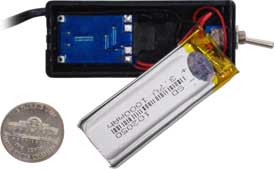 external power, whether from a USB power source or from another, larger, battery. external power, whether from a USB power source or from another, larger, battery.Shown at left and below is the external battery used with VisorCam (illustrated in next section, below). This unit is equipped with its own battery management board (BMS) which is matched with battery to safely maintain and charge this specific battery. In this case, we have a 1000mAh (1A) lipo battery connected to a TP-4056 BMS board providing . 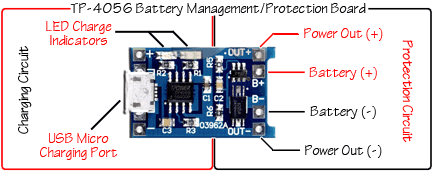  Hard-wired DashCam, or battery-powered and portable ActionCam? Tough choice. Why not do both? 8^) |



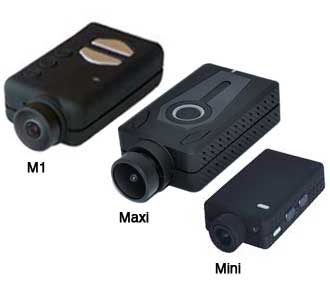 Mobius programmable FHD These tiny video cameras are nothing short of spectacular. They have evolved and improved over the years, from the first Mobius model (M1) to the much improved Mobius Maxi and it's little cousin the Mobius Mini.
Three M1s served in a variety of motorcycle roles for over two years - as hard-wired DashCam, external-battery TailCam and as a HelmetCam. They've survived multiple trips across the desert, thru mountain passes and along the coast without so much as a dropped frame. While the M1 can record 1080p/60fps, I used 720p/30fps back in the day. Since upgrading to the Mobius Maxi and new Mini models with improved lens, chipset, recording time and vastly improved video quality, I've switched to 1080p/30fps, tho the Maxi is capable of more. The Mini has its own set of specs: 1920x1440 or 1080p @ 30/60fps, 720p up to 120fps, and VGA up to 240fps. (The high fps settings produce slow motion.) All Mobius cams may be ordered with their "standard" (A) lens or a wide-angle (B) lens and they have a variety of options designed for use on drones and RC vehicles, or for use as DashCams, SecurityCams, SpyCams or most any other use you can think of. FOV is adjustable via programming (wide or narrow). Manufacturer has included many features designed for those of us who like to modify these things, with the understanding that their product will most likely suffer such a fate (as all of mine have). For less than $100, audio/video quality is every bit as good as $200-300 cameras. Links posted at bottom of this page provide a detailed history of these cameras along with support sites and vendors. Teardown: Two tiny screws allow case to be opened and removed. Lens is attached to printed circuit board (PCB) by a ZIF ribbon connector or snap-connector, depending on model. Internal battery unplugs, lens lifts out, 3-4 screws removes PCB from case. Lens Replacement:
Lens holder is a standard M-12 mount with a set screw in the M1 model; I've changed out lens in favor of longer 6mm, 8mm and 12mm lenses with no difficulty, using WebCam mode to adjust and set lens focus. The Maxi, with its programmable FOV, pretty much eliminates need to swap lenses - and video is so fast and smooth that it's difficult improve upon. Format and file types: All these cameras are capable of formatting their own SD cards, up to 128GB in the Maxi and 64GB in Mini (class 10 or better). Videos are H.264 MOV, MP4 or AVI. Image may be flipped with a slew of other programmable features. 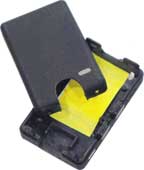 Simple: A few cuts to modify case, cut a circle out of top cover (right), and lens can be angled up to 115-degrees from camera body. (Yellow plastic strip protects thermal pad during mods.)
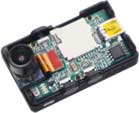 Once case mods are complete, lens sits nicely in remaining guides with ribbon cable delicately reshaped to eliminate any stress. With battery in place, top cover secures lens in its new position aided by fitting a lens hood. Back of camera mounts to 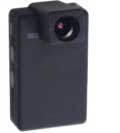 an aluminum bracket that acts as a heatsink while securing cam, tucked in between sissy bar and passenger back rest. Lens was placed at a very specific 75-degrees for this application and lens hood reduces glare from chrome and reflected sunlight. Bracket also holds on/off switch and connection to external battery (more about external power below). Only the TailCam's lens peeks out from backrest, camera is nearly invisible. an aluminum bracket that acts as a heatsink while securing cam, tucked in between sissy bar and passenger back rest. Lens was placed at a very specific 75-degrees for this application and lens hood reduces glare from chrome and reflected sunlight. Bracket also holds on/off switch and connection to external battery (more about external power below). Only the TailCam's lens peeks out from backrest, camera is nearly invisible.Mobius Mini BarCam (or BodyCam) Mod
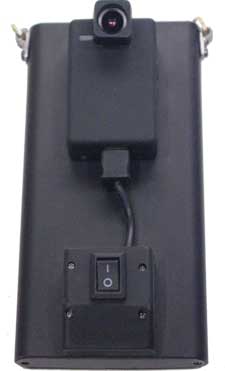 Photo at left is another specialty mod of the Mobius Mini. This one has lens angled to its maximum 115º pointing slightly downward, specifically designed for motorsport use. Photo at left is another specialty mod of the Mobius Mini. This one has lens angled to its maximum 115º pointing slightly downward, specifically designed for motorsport use.This Mini was mounted to the aluminum housing of a cell phone power bank that dwarfs camera and provides both heat sink and 5,000mAh of power. Glove-friendly rocker switch starts and stops recording (by providing external power ala´ Mobius program), lens angle is precisely fixed to keep video centered and level, also secured by lens hood. Camera is worn around neck with lens near jacket collar. Calculations from real-time tests on this camera indicate a full 8-hours of recording time per 32GB (class 10) SD card with video set to 1080p @ 30fps. 20 min.=4GB. Using a 64GB SD card (camera's max) would record 16 hours. Battery will go for days before needing a charge. (Next BarCam will be prettier.) 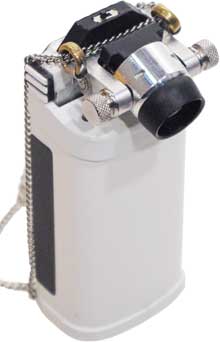 Mobius Maxi BarCam
4th version BarCam uses a Maxi board and lens, and sports some major improvements.
With Maxi's bigger and faster lens on a swivel, unit is powered by a 2500mAh battery behind four SuperCaps ensuring proper end-of-file and shutdown.
Independent charge and operating circuits extend battery life by preventing drain during storage. Charge circuit uses a 4056 board while operating circuit has its own step-up buck converter providing 1A at 5v from the internal 3.7v lithium battery.
Easy to find (glove-friendly) on/off slide switch at very top of unit controls ops. Camera body is streamlined and heavy enough to resist wind at high speed.
Like its predecessors, camera is suspended on a chain worn around the neck. Brass loops support camera from chain and allows active head movement while riding without disturbing camera position.
Programming Mobius cams
Mobius provides a programming utility created in conjunction with state-side Mobius fans, but it's merely a graphical interface and is really unnecessary. Camera's script can be dumped onto cam's SD card, then edited with any text editor app (TextEdit on a Mac). Script is a straight-forward line-item list of settings and options, set on/off by putting a 1 or 0 in the brackets next to each function. Multiple choice options are numbered; some settings, like exposure and color balance, require a numeric value but default settings are best in most cases. Simple. Once adjusted, script loads back into camera via SD card. Mobius recommends formatting SD cards within the camera, which is best, but Apple's Disk Utility may also be used with these settings: 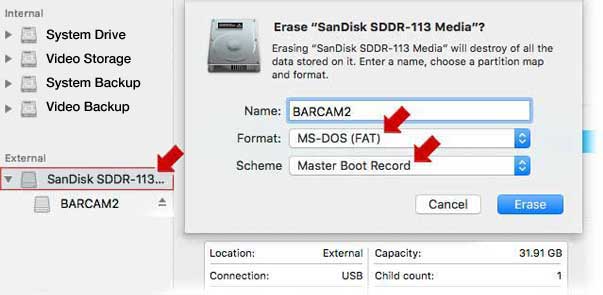 Always use quality name-brand SD cards from a known vendor; many - if not most - recording issues can be traced to media failure, corrupt/improper format or an SD card that's not up to Class 10 specs. GitUp F1 Helmet Cam
The GitUp F1 produces outstanding audio and video (aside from wind noise), but its greatest asset is image stabilization at 1080p. Helmet cams are almost useless without stabilization, and the F! does a spectacular job.
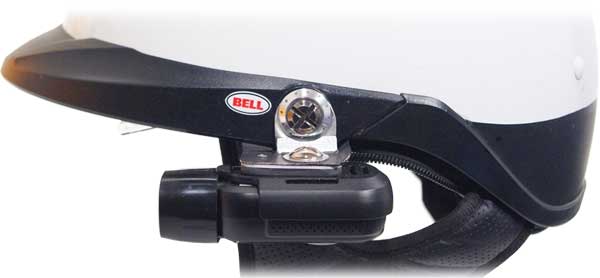 Zoom function takes helmet out of the shot while enlarging focus on target. It also has an optional wireless control, but large start/stop button on top of camera body is easier to use when mounted (upside-down) on helmet. Flip function compensates for inverted mount. Only complaint I have with the F1 is the file format it records in, but converting format is a small price to pay for camera's image quality and stabilization.
Mobius Maxi as DashCam
Pictured at the top of this (too-long) diatribe between the M1 and Mini, the Mobius Maxi is a stout and stellar performer, limited only by the maximum size of its micro-SD card (128GB). Using our formula for 1080p/30 at 4GB per 20-minutes, that's 640 minutes or 10.6 hours recording time per card.
Used as a DashCam, it can be set to loop - or not - and will save/lock select clips manually or automatically via its G-sensor. It has a host of other features and capabilities, mounts and options, far too many to list here. On the bike, this cam is mounted inside a protective case behind a crystal 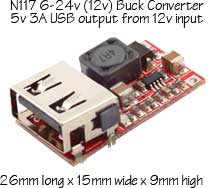 lens and is clamped direct to handlebars - no modifications needed beyond mount and power source. lens and is clamped direct to handlebars - no modifications needed beyond mount and power source.Camera is connected to an unused circuit within headlight bucket, activated by ignition switch, and uses another N117 Buck converter to step down from 12v to 5v USB (right). N117 is also stashed within headlight bucket where it also feeds a GPS unit from time to time. Had some teething problems with the Maxi early on - it seems to like recording in 1-minute clips - but once sorted, the Maxi has been nothing short of awesome, and no less remarkable given its price point. You can get four of these for less than a single GoPro without compromising video quality - and all four together are less than half the size of a GoPro's. What's not to like? |



|
Drift HD 720 Camera - old model - teardown & mods ADDENDUM: Drift cams have changed considerably since this teardown was posted; unknown if any of this applies to the new Ghost XL and XL Pro cams. Not sure I'd tear into a $300 unit to find out. Maybe...
Objective here was to replace cam's wide-angle 130º lens with a "normal" lens, in this case a 6mm/50º lens with new mount and IR-cut filter. (Changing lenses means replacing lens, mount and filter as a unit because original assembly cannot be taken apart or modified. If you try, you're likely to destroy all three.) Disassembly begins with removing back cover, battery and SD card. Remove four 1.5mm hex screws and lens cover. Flip camera upside-down and remove six long 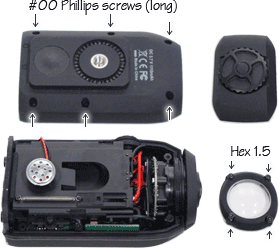 phillips screws from bottom-half of camera case. phillips screws from bottom-half of camera case.Lift bottom case straight up, pull speaker loose from case (if necessary), set bottom case aside. Note spring-loaded battery eject mechanism and location of antenna wire. Remove eject spring and arm (to avoid losing 'em). Loosen rubber seal from rear of case and peel it forward toward lens, popping mic out of its rubber mount (see below). Holding seal toward lens, free antenna wire, then move battery box aside exposing circuit boards and lens assembly. Next step is the delicate process of releasing ZIF connector and removing internals from top case. (If you're only replacing lens, you might be able to skip this step and work with only bottom case removed.) ZIF release is a brown tab that _slides_ about 1/16" away from connector toward case wall. Remove screws from circuit board, then free circuit board assembly from top case by lifting lens end first. Ribbon cable should slide out of ZIF connector. Set top case aside. 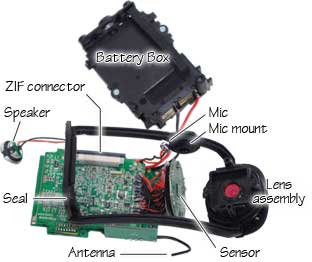 Mark sensor board and corresponding side of lens mount for reference on reassembly; bear in mind that lens is upright when camera's display is on RH side and lens housing is aligned with case. In a dust-free environment, remove four screws between sensor board and lens mount while holding all firmly in place to avoid damaging sensor. Two of these fasten board to mount, the other two are longer and pass thru to lens housing. Remove lens+mount from housing/seal by pressing lens rearward (press fit). Store original lens/mount assembly in a sealed bag in case you might want to return cam to its original configuration - resist temptation of removing lens from mount. Replacement mount with a proper IR-cut filter may be 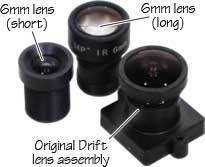 obtained from B&H Photo in New York (SKU = MAVLH4IR, security lens holder w/FBG28 filter, link below). New M12 mount will need to be filed down slightly on all four sides, but will then fit into Drift's rotating housing perfectly. And the IR-cut filter from B&H is excellent. obtained from B&H Photo in New York (SKU = MAVLH4IR, security lens holder w/FBG28 filter, link below). New M12 mount will need to be filed down slightly on all four sides, but will then fit into Drift's rotating housing perfectly. And the IR-cut filter from B&H is excellent. Lens must be a SHORT one to accommodate the Drift's lens cover. The two 6mm lenses shown here are both megapixel models with nearly identical optical specs, but the long one (22.5mm in length) will not fit behind lens cover when focused. The shorter model fits, but there's another problem: Drift's convex lens cover prevents sharp focus with normal lenses. So, we added a gasket cut from 1/8"-thick neoprene rubber and used a flat glass crystal. We also added a thinner O-ring to replace the Drift's seal. Lens must be a SHORT one to accommodate the Drift's lens cover. The two 6mm lenses shown here are both megapixel models with nearly identical optical specs, but the long one (22.5mm in length) will not fit behind lens cover when focused. The shorter model fits, but there's another problem: Drift's convex lens cover prevents sharp focus with normal lenses. So, we added a gasket cut from 1/8"-thick neoprene rubber and used a flat glass crystal. We also added a thinner O-ring to replace the Drift's seal.Focus and fine tune before reassembly NOTE: If you haven't removed the battery eject spring and arm, now is a good time. Once eject has been removed, insert a battery and SD card, power up and install lens. Focusing this cam is a bit more difficult than those with HDMI output than can be focused on a large screen. We used an Air Force test target with the Drift's display as a starting point, then shot test video using index marks to fine-tune camera focus. 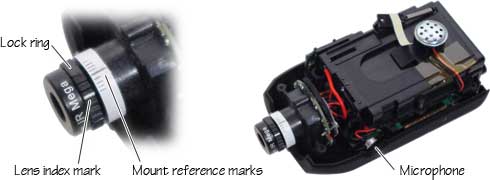 Microphone breakout Moving the mic outside the lil' Vivitar (above) and into a muff was such an enormous improvement in audio quality, I just had to do the same for the Drift cam. Using the 8mm TailCam, I removed the Drift's mic, soldered it to a short stereo cable with a 2.5mm plug (ignoring center connector) and reinforced connection with some stiff shrinkwrap. Mic was placed into a very soft, hollow silicone grommet - just like Vivitar mic above - to further deaden any vibration and give the mic a little more mass. 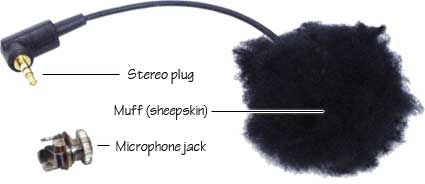 Muff is made from a circle of sheepskin about the size of a silver dollar with a tiny hole punched thru leather at mic, then drawn tight with a stitch around perimeter. Foam muffs are available from Radio Shack, or foam tips from earphones might work, too.
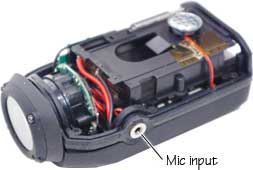 The original Drift microphone mount has a hard plastic T-shaped spacer within its rubber socket; inside diameter is perfect for 2.5mm jack, using the smallest, round, panel-mount jack available. Jack's switch contact was carefully cut off - snug fit inside rubber mic socket - and that T-shaped spacer had to be shortened a bit to allow plug to seat properly. Naturally, the thin rubber mic cover had to be pierced, which may compromise the Drift's weatherproof seal but useful audio sans wind noise is absolutely worth it. (The little Vivitar 480 has slightly better audio tho, sorry to say, even with same mic.) The original Drift microphone mount has a hard plastic T-shaped spacer within its rubber socket; inside diameter is perfect for 2.5mm jack, using the smallest, round, panel-mount jack available. Jack's switch contact was carefully cut off - snug fit inside rubber mic socket - and that T-shaped spacer had to be shortened a bit to allow plug to seat properly. Naturally, the thin rubber mic cover had to be pierced, which may compromise the Drift's weatherproof seal but useful audio sans wind noise is absolutely worth it. (The little Vivitar 480 has slightly better audio tho, sorry to say, even with same mic.)This 6mm cam was used in FOV demonstration at top of this page, along with a stock wide-angle 2.5mm Drift and a third Drift with 8mm lens installed. |



|
The 808 family of Keychain Cams: Last but not least is a wide variety of tiny HD cameras loosely known as 808 cams from Hetai in China, latest iteration being model #18. The camera that started it all was a tiny keychain cam that shot such remarkable video it quickly became popular with hobbyists of all kinds, mounted on drones, model aircraft, boats, cars and even pets. It has since gone thru dozens of revisions and improvements, morph'd into pen cams, lapel cams, and more. Point is, these folks are serious, and their cameras come in about any configuration you can think of. Hidden in smoke detectors and alarm clocks, they shoot such excellent video and are so cheap they're extremely popular as nanny cams and spy cams. Some people probably still carry them on keychains, but I'm guessing smart phones are the new go-to for video.
Internals of an early 808 cam:
 Original 808 keychain cam (shown actual size). Micro SD card slot has card installed, USB port, microphone in upper-left, lens on left, rechargeable battery on right.
These cameras are still available via select vendors on eBay, and some are also sold thru retailers, but beware of countless fakes out there and only deal with recommended vendors. See links at bottom of page. |



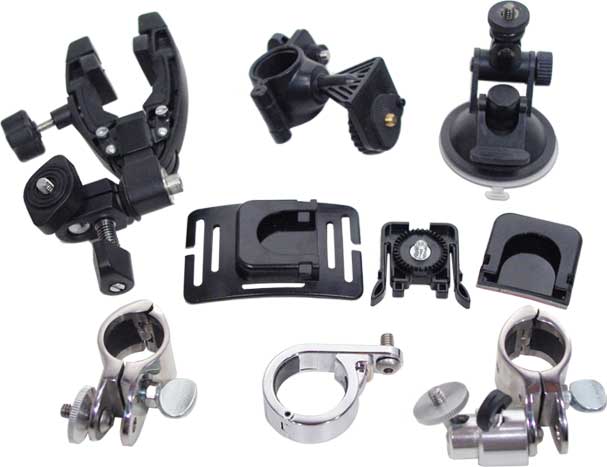 All ActionCams come with a variety of plastic mounts, typically handlebar and helmet mounts. Specialized mounts are available in countless configurations, too. At top-left is an anodized aluminum clamp designed for versatility with a ball-mount at camera and a set of jaws that will grab onto just about anything. Next is a rather awkward handlebar mount, then a typical suction-cup windshield mount, and in the middle is a two-part scheme where center piece threads into camera then clips into either of the concave helmet mounts on either side of it (left one takes a strap and right one has adhesive). My fav is the stainless clamp at bottom-left; found at a marine store on eBay and modified, it's as short and stout as possible. The one on bottom-right has a swivel head added from a $5 tripod. Between them is a modified "P" clamp for 1.25" bars from Amazon.
What I eventually settled on is a kit for an extra portable cam containing two mounts, a Mobius Maxi (with internal SuperCaps), remote power and switch:
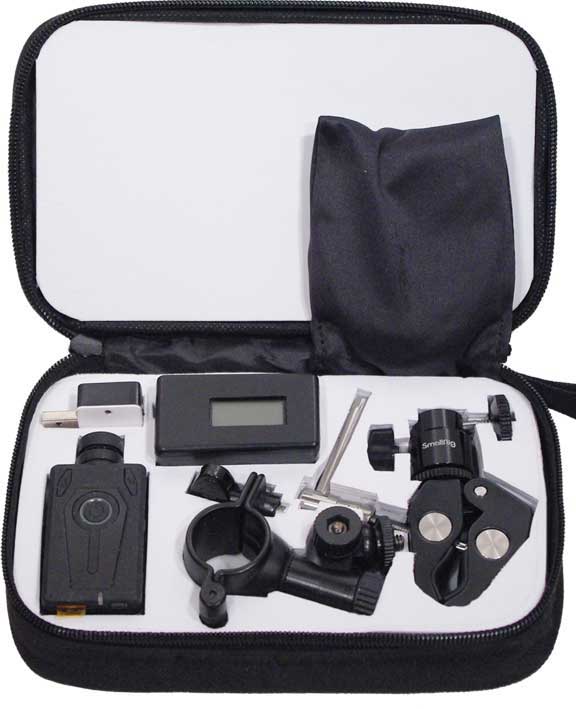 Clockwise from left: Start/stop switch, handlebar magnet-mount power bank with LCD readout, a great all-purpose mount from SmallRig (link at bottom), a lightweight plastic handlebar mount, and the Mobius Maxi. Bag in top-right of case contains a few lightweight USB power cables of various lengths.
In addition to mounted dashcam and tailcam, this kit allows video from the side, down low, or any desired angle. 18650 charge unit (HSY H913-A) has readout, buck converter and 1200mAh battery in a case with two monster magnets for sticking on handlebars.
Since our primary focus here is mounting cams on motorcycles, we have problems to deal with that might not apply to other vehicles, starting with vibration and a phenomenon known as "CMOS wobble" - which is all but unavoidable. Camera size/weight and base mount are critical to minimizing the problem, but somewhere along acceleration curve it will rear its ugly head.
CMOS wobble occurs when motor rpm hits a harmonic frequency causing camera sensor to react with wavy video, and it's completely unpredictable. Even the smoothest engine is likely to trigger it briefly when going thru the gears. Using the short stainless mount, Vivitar's tiny 3 oz. CMOS cam seems to avoid it, tho I haven't really tested the Vivitar at high rpm. The much larger Drift cam recorded CMOS wobble right around 3700 rpm on a recent trip, but that is sure to change with different mount, location or camera. Just know that defeating vibration is one thing, but chasing CMOS wobble will probably be an ongoing battle. Not all motorcycles are the same in this regard, either. Mine happens to be smooth as silk, even at idle; only the mirrors get a bit blurry at high speeds. Some other bikes vibrate so much they're likely to beat a camera to death. The Mobius cams have been stellar in this regard, and body cams and helmet cams are naturally immune. CMOS wobble hasn't been noticeable, tho I know it has to be there somewhere.
|



References |
| Tom Frank's Mobius1 cam pages - Site protocols, Mobius1 cam support Tom Frank's MobiusMini cam pages - Specs, pics, internals of the Mobius Mini Tom Frank's MobiusMaxi cam pages - Specs, pics, internals of the Mobius Maxi Tom Frank's Keychain cam pages - Internals of #18 micro cam and vendors DashCamTalk MobiusMaxi - Site dedicated to Dash Cams, reviews and use |
Sources |
| B&H Photo and Video - A+ source for cameras, computers and accessories B&H M12 lens mount w/IR-cut filter - SKU = V-LH4-IR w/FIRC-650 filter B&H handheld Camcorders - great source, various brands, specs, prices B&H Sports and ActionCams - GoPro, DJI, Drift, Sony, countless others Drift cameras, US - Cams, vendors, accessories, features Gitup cameras - Stabilization in tiny F1 models, 90º, 130º, 160º lenses M12 Lenses - M12 lenses and mounts (most will need an IR-cut filter) Mobius Mini and Maxi cams on eBay - Eletoponline365 (direct source) SmallRig camera mounts - Outstanding mounts of all kinds Wasabi batteries and Chargers - from Blue Nook on Amazon |











